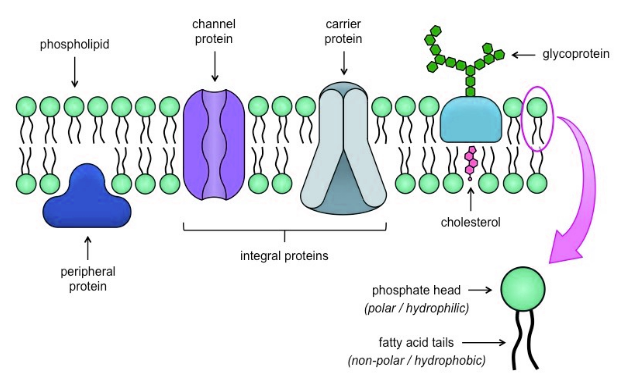
Assertion – The quasi-fluid nature of lipid enables the lateral movement of proteins within the overall bilayer.
Reason – This ability to move within the membrane is called fluidity and is important for cell growth.
(a) Both Assertion and Reason are correct and Reason is the correct explanation for Assertion
(b)Both Assertion and Reason are correct but Reason is not the correct explanation for Assertion
(c) Assertion is correct but Reason is incorrect
(d) Both Assertion and Reason are incorrect
Answer
490.5k+ views
1 likes
Hint:The fluidity of the cell membrane is important for functions like cell growth, the formation of intercellular junctions, secretion, endocytosis, cell division, etc. and is due to the presence of cholesterol in the cell membrane.
Complete answer:According to the fluid mosaic model of cell membrane proposed by Singer and Nicolson, due to the quasi-fluid nature of the lipids, the proteins in the membrane become able to move laterally within the lipid bilayer which is known as the fluidity of the membrane.
This fluidity is important not only in cell growth but also in various other important functions like the formation of intercellular junctions, endocytosis, cell division, secretion, etc. In the given question, the reason is correct but is not explaining properly what is said in the assertion. A diagram representing the fluid mosaic model of the cell membrane has been given below in which the different types of molecules present in this model have been indicated.
The fluidity in the cell membrane is due to the presence of lipids and this is because the fatty acid chains in the phospholipids are often unsaturated and they don't pack tightly together. Due to the absence of a tight packing, proteins and lipids in the membrane can move laterally whenever required.
So, the correct answer is ‘Both Assertion and Reason are correct but Reason is not the correct explanation for Assertion’.
Note:There are three types of movements that a protein can acquire in a lipid bilayer. The first one is the lateral movement which is too quickly than the other two movements. The second one is rotational movement and the last one is the flip-flop movement in which the protein in one bilayer moves to a place in the other bilayer.

Complete answer:According to the fluid mosaic model of cell membrane proposed by Singer and Nicolson, due to the quasi-fluid nature of the lipids, the proteins in the membrane become able to move laterally within the lipid bilayer which is known as the fluidity of the membrane.
This fluidity is important not only in cell growth but also in various other important functions like the formation of intercellular junctions, endocytosis, cell division, secretion, etc. In the given question, the reason is correct but is not explaining properly what is said in the assertion. A diagram representing the fluid mosaic model of the cell membrane has been given below in which the different types of molecules present in this model have been indicated.
The fluidity in the cell membrane is due to the presence of lipids and this is because the fatty acid chains in the phospholipids are often unsaturated and they don't pack tightly together. Due to the absence of a tight packing, proteins and lipids in the membrane can move laterally whenever required.
So, the correct answer is ‘Both Assertion and Reason are correct but Reason is not the correct explanation for Assertion’.
Note:There are three types of movements that a protein can acquire in a lipid bilayer. The first one is the lateral movement which is too quickly than the other two movements. The second one is rotational movement and the last one is the flip-flop movement in which the protein in one bilayer moves to a place in the other bilayer.

Recently Updated Pages
Express the following as a fraction and simplify a class 7 maths CBSE

The length and width of a rectangle are in ratio of class 7 maths CBSE

The ratio of the income to the expenditure of a family class 7 maths CBSE

How do you write 025 million in scientific notatio class 7 maths CBSE

How do you convert 295 meters per second to kilometers class 7 maths CBSE

Write the following in Roman numerals 25819 class 7 maths CBSE

Trending doubts
A boat goes 24 km upstream and 28 km downstream in class 10 maths CBSE

The Equation xxx + 2 is Satisfied when x is Equal to Class 10 Maths

What are the public facilities provided by the government? Also explain each facility

Difference between mass and weight class 10 physics CBSE

SI unit of electrical energy is A Joule B Kilowatt class 10 physics CBSE

Why is there a time difference of about 5 hours between class 10 social science CBSE




